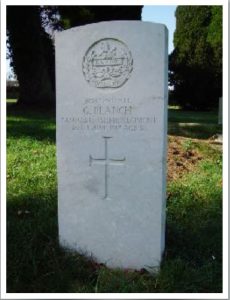12th Battalion, Gloucestershire Regiment

George Blanch was born on 10 November 1880 at Scowles, near Coleford in the Forest of Dean.
He was the son of Jeremiah and Harriet (née Perkins) Blanch, who at the time of the 1901 Census had seven children. In 1911 George was lodging with the Carter family at Sparrow Hill, Coleford and was employed as a roadman.
He enlisted for military service, for the duration of the war, probably under ‘Lord Derby’s Scheme’, on 10 December 1915. He stated his occupation then to still be a ‘roadman’ and his address as Stanton Road, Coleford; he was unmarried.
He was mobilised on 15 May 1916, initially joining the 3rd (Reserve) Battalion of the Gloucestershire Regiment, based at Sittingbourne, Kent before joining up with the British Expeditionary Force (BEF) in France on 1 September 1916 and the 12th (Bristol’s Own) Battalion (part of 5 Division) of the Glosters at Ville-sur-Ancre (Somme) on 12 September. He was probably part of a reinforcement draft following an attack made on the German’s second defence line, running from Wedge Wood to the south-east of Guillemont. The 12th Battalion took part in a further attack, at Morval, on 25 September before entraining for Festubert on 1 October, where the battalion remained at rest until March 1917.
On 20 March 1917 Private Blanch reported sick to 13 Field Ambulance and exhibiting indications of pulmonary tuberculosis.
He was sent, via No 23 Casualty Clearing Station to No 11 General Hospital, Camiers and thence to England on 6 April 1917 and the Military Hospital at Shorncliffe.
A medical board convened on 12 April 1917 confirmed the diagnosis of pulmonary tuberculosis and it was considered that had been present before enlistment but had been aggravated by military service. A full disability pension was granted for an initial six months. Discharge from the Army on the grounds of ‘no longer physically fit for war service’ followed on 3 May 1917 and a Silver War Badge, denoting medical discharge from military service was awarded.
Initially George was sent to Cranham Lodge Sanatorium near Brockworth and there was a subsequent death notice in the Gloucestershire Journal of 30 June 1917 stating that he died at Newland Street, Coleford on 20 June 1917. He was 36 years old.
George was buried in Coleford Town Cemetery but his grave was either unmarked or its marking had disappeared. Until very recently his name did not feature as a casualty in the CWGC records. As he appeared to qualify as a casualty of the Great War, Eric Nichols, a resident of the Forest of Dean, contacted the In From the Cold Project, whose aim is to bring such cases to the CWGC with a view to them being properly commemorated. It transpired that this was a case with which they were already dealing and the CWGC has now accepted Private George Blanch as a casualty of war and in due course a commemorative headstone should be put in place at Coleford Cemetery.
Thanks go to Eric Nicholls for work done in researching this story – Graham Adams 16 March 2016
